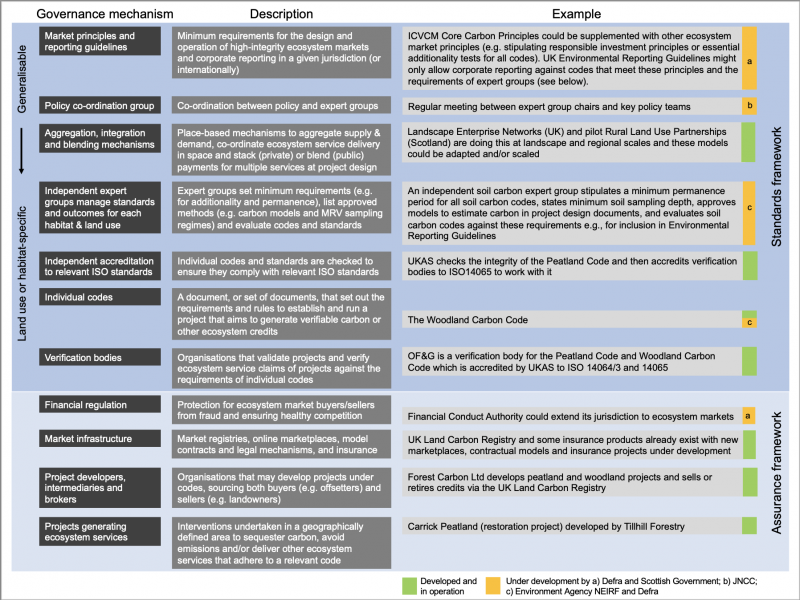
Q&A
1. Why is there a need for the Farm Soil Carbon Code work?
Across the UK, a marketplace is emerging that pays farmers to undertake regenerative agro- ecological farming practices – i.e. practices that sequester carbon into the soil. These schemes operate according to different rules and standards, however, and have different approaches to the measuring, reporting and verification (MRV) of farm soil carbon, as well as to some of the critical ‘principles’ at stake, for example requirements for permanence in carbon or additionality rules.
This lack of consistency between different projects, standards and schemes is confusing for farmers and investors alike. There are concerns that some of these schemes may not yield additional or permanent climate mitigation benefits and may not provide adequate protection to buyers and sellers. Put simply, a unit/credit of carbon achieved on one farm might not be equivalent – or even comparable with a unit from another.
This is where our work steps in. Our aim is to bring some much-needed clarity, consistency, fairness and integrity to the marketplace while maximising the environmental and economic impact of soil carbon sequestration.
2. How are you going to bring clarity, consistency, fairness and integrity to the marketplace?
Over the past nine months we have consulted extensively with farmers, businesses and other experts to better understand what they feel is needed to improve the marketplace. In particular we wanted to address the confusion and uncertainty caused by the variety of different schemes in existence, help both farmers and investors decide which scheme to engage with and provide peace of mind about what outcomes will be achieved – both economic and environmental.
This is important because farmers do not want to over-promise soil carbon that doesn’t actually materialise through no fault of their own, and investors do not want to pay for changes that would have happened anyway, or that get ploughed up and emitted back into the atmosphere at a later date.
We reached the conclusion that the swiftest and most effective way to add value to the marketplace was through the creation of ‘Minimum Requirements’, against which existing codes/projects could be evaluated and should be able to meet in order to function in the UK marketplace. These requirements will address the following three elements:
- The Evidence Base that underpins them, including the quality of the evidence demonstrating the likelihood of carbon sequestration or emissions reduction in eligible project types/locations, and
- The Code Specification, their approach to some of the critical principles at stake – additionality, permanence, leakage etc.
- The Monitoring, Reporting and Verification (MRV), how they use empirical data to establish change over time – e.g. the depth of soil testing, analytical, sampling and modelling methods used, approaches to determining reliability and accuracy of measurement and modelling methods.
It is our hope that these minimum requirements will achieve a “levelling up” of the marketplace, and shine a spotlight on less scrupulous players, encouraging them to raise their game.
3. Are you going to create a Farm Soil Carbon Code?
As explained above, we do not feel that a single, commercially operated and independent code along the lines of those that exist for woodland and peatland – one with its own fully defined rules, methodologies and approaches to MRV is what the marketplace needs right now – or would add a great deal of value to either farmers or investors.
There are other reasons why a new, independent code would not be practicable at this stage:
- Any such code would have to be run by a registered company with the necessary resources needed to set-up, operate and maintain it as a commercial entity into the foreseeable future, and promote and market it. We do not have those considerable resources at our disposal.
- Such a code would not offer anything different to that already available from well-established codes already operating globally in the marketplace.
- Even though our work is supported by the Environment Agency, any code we create would not have any official backing, meaning no formal requirement for projects to comply with it. Its uptake would depend on demand from credit buyers unless adopted by any government authority (in each devolved administration).
The decision – that a code should not be the critical output from our work - was reached following extensive stakeholder engagement. The approach that we are proposing was presented to a Workshop in April 2022, and endorsed by participants on the day and via a subsequent poll.
4. How will these minimum requirements be established and governed?
To help us create these requirements, we will shortly be publishing a draft evaluation framework, based on the outcomes of the research: What makes an operational Farm Soil Carbon Code? Insights from a global comparison of existing soil carbon codes using a structured analytical framework that was recently accepted in the journal, Carbon Management, which identified the evidence-based principles needed for the development and operation of high-integrity agricultural soil carbon markets in the UK.
At the same time, we will publish a draft governance framework which will demonstrate how the evaluation of codes, standards and schemes will be managed, decisions reached, support given and the principles underpinning the evaluation process kept up-to-date.
Both of these elements will be subject to external consultation, and we will welcome input from all stakeholders on them.
5. Will the Evaluation Framework evolve over time?
Yes. As the governance framework will explain, we envisage establishing an expert group that will be able to keep requirements under review so they can adapt to the latest evidence and policy developments as they become available.
This approach might be duplicated by other nature-based carbon markets i.e. an expert group could be established for e.g. hedgerows, saltmarsh etc, and each group would develop an evaluation framework based on evidence-based principles for the development and operation of high-integrity carbon markets in their domain, with an accompanying governance framework to ensure transparency and accountability.
This expert group might also be responsible for drafting guidance on the range of appropriate methods for monitoring, reporting and verification, minimum permanence periods for soil carbon projects and requirements that will safeguard the additionality of carbon.
There will be full transparency – including a governance framework to ensure the independence and expertise of the group, and an appeals process for codes, standards and schemes that are not happy with the decisions made.
6. How does your work fit into the broader policy framework in this area?
Policy is evolving rapidly in this space – both at UK and devolved level, and we are exploring ways in which our work can integrate into this process and support the delivery of policy objectives.
One option might be for our evaluation framework to be used to reach decisions on whether to recommend integration with the UK Government’s Environmental Reporting Guidelines. Alternatively, trading platforms offering credits from different habitats and land uses could use evaluations to inform their ratings of projects and carbon credits, enabling price differentiation for high-integrity carbon projects. This approach could potentially be used to enable existing codes to register credits with the UK Land Carbon Registry, and therefore support a comprehensive ecosystem carbon marketplace, with existing peatland and woodland codes plus other habitat codes in development.

7. What is the Community Code, and how does it fit in?
The ‘Minimum Viable Community Code’ (MVCC) is an option that the Consortium might develop in the future.
The MVCC would be created to address the particular needs of UK soil carbon projects that would not be viable or are not served by the existing codes and/or marketplace. It would be built around UK specific needs - as the Woodland and Peatland codes were - and include clearly defined approaches to specific challenges - e.g. how to integrate them with other ecosystem services and the thorny issue of additionality - how to successfully blend public and private income sources.
As it stands, we are unsure about the exact scope and detailed content of an operational version of the MVCC, but will look to establish this once we are clearer about issues over viability, constraints to using existing codes, alternate objectives are better understood e.g. wider policy benefits, alternate commercial objectives. It will also require some degree of subsidy/contribution from public/private funding for its operation - (similar to woodland and peatland codes, managed in kind by Forestry Commission and IUCN, respectively).
8. Will your standards be applicable for all players in the farm soil carbon marketplace?
It is important to understand that there is not one single soil carbon marketplace, but in fact several different ones driven by different environmental and business objectives. These include the Voluntary Carbon Marketplace (VCM) whereby businesses can reduce the net carbon balance of their own emissions through off-setting, the insets marketplace where food and drink businesses can reduce their Scope 3 emissions through their supply chain and the ecosystems marketplace where investors pay land managers for the environmental benefits that certain practices generate – biodiversity increase, water regulation, as well as increased soil carbon.
When we began this work, our attention was focused on the VCM, and the need to establish standards there, however we have discovered that where there is also a high-level of interest – and potential for growth - is in the insets and Scope 3 emissions, with food and drink businesses looking to promote regenerative practices throughout their supply chain.
It is important to note that, the MRV elements (soil carbon stocks and soil derived GHG emissions) are the same whether insetting or offsetting, and so the MRV elements will be applicable across the board.
9. Your work looks to give the soil farm soil carbon marketplace some assurance and a (soft) regulatory structure. Will it also help the market grow?
Yes. Alongside the Minimum Standards, we will also generate Guidance to reflect the different needs of different market users – offsetters, insetters, ecosystem services buyers – where it is needed as long as baseline criteria provided by the baseline standards are met.
This might include workable approaches for additionality, permanence etc. based on best practise that we have identified from existing programmes and approved codes that can then be applied in the UK context.